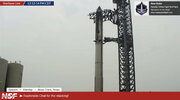Launch Date: April 20
Launch Window: 8:28am CDT (6:28am PDT, 13:28 UTC) - 62 minute window
Launch site: LC-1? - Starbase, Boca Chica Beach, Texas
Core Booster Recovery: Expended in Gulf
Starship Recovery: Water landing near Hawaii
Booster: Super Heavy Booster 7
Starship: Starship 24
Mass: No mass simulator mentioned
Orbit: LEO-ish
Yearly Launch Number: 26
A SpaceX Super Heavy and Starship launch vehicle will launch on its first orbital test flight. The mission will attempt to travel around the world for nearly one full orbit, resulting in a re-entry and splashdown of the Starship near Hawaii.
Webcast:
Launch Window: 8:28am CDT (6:28am PDT, 13:28 UTC) - 62 minute window
Launch site: LC-1? - Starbase, Boca Chica Beach, Texas
Core Booster Recovery: Expended in Gulf
Starship Recovery: Water landing near Hawaii
Booster: Super Heavy Booster 7
Starship: Starship 24
Mass: No mass simulator mentioned
Orbit: LEO-ish
Yearly Launch Number: 26
A SpaceX Super Heavy and Starship launch vehicle will launch on its first orbital test flight. The mission will attempt to travel around the world for nearly one full orbit, resulting in a re-entry and splashdown of the Starship near Hawaii.
Webcast:
Attachments
Last edited:




